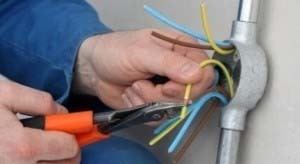 | ||
Low-Frequency and Power Transmission Termination
Electrical termination is an electrical industry term used to describe the specific point at which a conductive device, such as wire or cable, ends or starts. The conductive device may or may not pass the carried electricity or signal onto another conductive device at this point. A common point of electrical termination is at a terminal block. A wire typically ends, or terminates, at the terminal block; but the electricity or signal may be passed onto the terminal connectors.
Contents
- Low Frequency and Power Transmission Termination
- High Frequency Signal and Transmission Line Termination
- Passive
- Active
- SCSI
- Controller Area Network
- Dummy load
- Ethernet coaxial 50 ohm
- Antenna network 75 ohm
- Unibus
- MIL STD 1553
- Issues
- References
Ordinary electrical cables suffice to carry low frequency alternating current (AC), such as mains power, which reverses direction 100 to 120 times per second, and audio signals. However, they cannot be used to carry currents in the radio frequency range, above about 30 kHz, because the energy tends to radiate off the cable as radio waves, causing power losses.
The higher the frequency of electromagnetic waves moving through a given cable or medium, the shorter the wavelength of the waves. Transmission lines become necessary when the length of the cable is longer than a significant fraction of the transmitted frequency's wavelength. Types of transmission line cables include parallel line (ladder line, twisted pair), and coaxial cable. and these require high frequency signal termination.
High Frequency Signal and Transmission Line Termination
Signal termination is a very different type of termination which often requires the installation of a special device, known as a terminator, at the beginning and end of a wire or cable to prevent an RF signal from being reflected back from each end, causing interference, or power loss. The terminator is usually placed at the end of a transmission line or daisy chain bus (such as in SCSI), and is designed to match the AC impedance of the cable and hence minimize signal reflections, and power losses. Less commonly, a terminator is also placed at the driving end of the wire or cable, if not already part of the signal-generating equipment.
Radio frequency currents tend to reflect from discontinuities in the cable such as connectors and joints, and travel back down the cable toward the source causing interference as primary reflections. Secondary reflections can also occur at the cable start, allowing interference to persist as repeated echoes of old data. These reflections also act as bottlenecks, preventing the signal power from reaching the destination.
Transmission line cables require impedance matching to carry electromagnetic signals with minimal reflections and power losses. The distinguishing feature of most transmission line cables is that they have uniform cross sectional dimensions along their length, giving them a uniform impedance, called the characteristic impedance, to prevent reflections. Signal terminators are designed to specifically match the characteristic impedances at both cable ends.
Types of transmission line cables include balanced line such as ladder line (Consumer television), and twisted pairs (Cat-6 Ethernet, Parrallel SCSI, ADSL, Landline Phone, XLR audio, USB, Firerwire, Serial); and unbalanced lines such as coaxial cable (Radio antenna, CATV, 10BASE5 Ethernet).
Passive
Passive terminators often consist of a single resistor, however significantly reactive loads may require other passive components such as inductors, capacitors, or transformers.
Active
Active terminators consist of a voltage regulator that keeps the voltage used for the terminating resistor(s) at a constant level.
Forced Perfect Termination can be used on single ended buses where diodes remove over and undershoot conditions. The signal is locked between two actively regulated voltage levels, which results in superior performance over a standard active terminator.
SCSI
All parallel SCSI units use terminators. SCSI is primarily used for storage and backup.
Controller Area Network
Controller area network, commonly known as CAN Bus, uses terminators consisting of a 120 ohm resistor.
Dummy load
Dummy loads are commonly used in HF to EHF frequency circuits.
Ethernet coaxial 50 ohm
10BASE2 networks absolutely must have proper termination with a 50 ohm BNC terminator. If the bus network is not properly terminated, too much power will be reflected, causing all of the computers on the bus to lose network connectivity.
Antenna network 75 ohm
A terminating resistor for a television coaxial cable is often in the form of a cap, threaded to screw onto an F connector. Antenna cables are sometimes used for internet connections; however RG-6 should not be used for 10BASE2 (which should use RG-58) as the impedance mismatch can cause phasing problems with the baseband signal.
Unibus
The Digital Equipment Corporation minicomputer Unibus systems used terminator cards with 178 Ω pullup resistors on the multi-drop address and data lines, and 383 Ω on the single-drop signal lines.
MIL-STD-1553
Terminating resistors values of 78.7 ohms 2 watt 1% are used on the MIL-STD-1553 bus. At the two ends of the bus, resistors connect between the positive (high) and negative (low) signal wires either in internally terminated bus couplers or external connectorized terminators.
The MIL-STD-1553B bus must be terminated at both ends to minimize the effects of signal reflections that can cause waveform distortion and disruption or intermittent communications failures.
Optionally, a high-impedance terminator (1000 to 3000 ohms) may be used in vehicle applications to simulate a future load from an unspecified device.
Connectorized terminators are available with or without safety chains.
